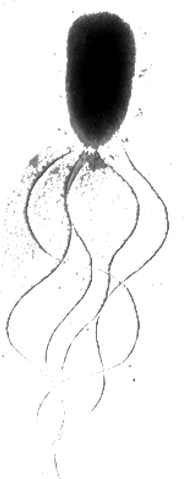 |
||||||
| School of Medicine • University of Washington • Box 357735 • 1705 NE Pacific St • Seattle WA 98195 | ||||||
| Harwood Lab: Pseudomonas aeruginosa | ||||||
Pseudomonas aeruginosa is an opportunistic human pathogen that persistently colonizes the lungs of people with cystic fibrosis and eventually kills them. It frequently causes septicemia in burn patients and urinary tract infections in catheterized patients. P. aeruginosa is also a pathogen of plants, insects and nematodes). It is widely distributed in nature and can be isolated from most soil and water environments. P. aeruginosa is highly motile and highly chemotactic to amino acids and a variety of other organic compounds. It swims in liquid environments by means of a single polar flagellum and it can also move on solid surfaces by means of swarming and pilus-mediated twitching. Bacteria that exist as single cells moving about and responding to their environment are often referred to as plankton. Planktonic cells have the advantage of being able to swim to new sources of soluble food.
|
 |
However, in some situations, which are not well defined, planktonic cells will adhere to surfaces and adopt a sessile existence. Sessile cells tend to proliferate on surfaces, eventually differentiating to form structured communities called biofilms that are encased in exopolysaccharide. Biofilm cells have certain advantages over planktonic cells. One is an ability to use insoluble polymers such as proteins, as food sources through the concerted action of exoenzymes produced by a concentrated population of cells. Another characteristic of biofilms that is advantageous to the microbe, but disadvantagous to humans, is resistance to antibiotics and biocides. P. aeruginosa infections are notoriously recalcitrant to antibiotic treatment. Part of the reason for this is that P. aeruginosa cells often exist as biofilms in infected patients. They form biofilms on indwelling medical devices such as urinary catheters and there is good evidence that P. aeruginosa cells exist as biofilms in the lungs of cystic fibrosis patients. | ||||